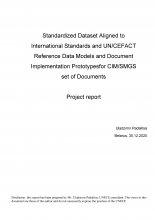
Standardized Dataset Aligned to International Standards and UN/CEFACT Reference Data Models and Document Implementation Prototypes for CIM/SMGS set of Documents
This pilot project was initiated in the context of implementing the recommendations of the 2019 and 2020 UNECE “Odessa seminars” to support the development of digital multimodal transport corridors, to increase the harmonization and standardization of data exchange in international transport, trade and logistics, to encourage electronic data exchange and thereby to reduce person-to-person contacts during the COVID-19 crisis and in the post-pandemic recovery, using relevant UN/CEFACT standards.
This included: an analysis of merchandise and information flows along the Black Sea – Baltic Sea corridor as background information for the further development of the project. A set of electronic messages (electronic document equivalents) based on the UN/CEFACT standards and Reference Data Models, using XML and JSON formats, has been developed in collaboration with relevant UN/CEFACT experts and using their guidance on how the UN/CEFACT standards should be applied to develop electronic document-equivalents for CIM/SMGS documents, in particular:
- Packing List;
- SMGS Consignment Note;
- CIM/SMGS Consignment Note (BY);
- CIM/SMGS Wagon List;
- Invoice for Customs (in cooperation with the Ukrainian consultant in the project).
A survey and analysis took place on what was necessary to accomplish for a complete conversion of data between maritime, road and railway transport. The focus was on new standards for generic document equivalents, in order to look into possibilities for their pilot implementation under the United Nations Development Account (UNDA) coronavirus (COVID-19) response project “Transport and Trade Connectivity in the Age of Pandemics”. The consultant worked in the areas of:
- practical aspects of preparing electronic standards for data exchange and new message structure subsets contextualized to the specific transport modes, using UN/CEFACT standards that would best service digital multimodal corridors and support modern technologies, including XML and JSON;
- development and implementation of a data model for the Black Sea – Baltic Sea digital corridor, combining the data for key documents accompanying goods, as described above, as identified in the project, and based on the UN/CEFACT Multimodal Transport Reference Data Model.
The main objective was to foster the harmonization of electronic data sharing, using global (UN/CEFACT) standards for transport, trade, and logistics, and to prepare templates for electronic document equivalents based on the UN/CEFACT semantic standards and reference data models.

Dnieper – Danube Corridor Pilot Dataset Alignment to International Standards and Data Models and Documents Implementation Prototypes for Use in Eastern Europe
Fulfilling the recommendations of the 2019 and 2020 UNECE “Odessa” seminars to support the development of digital multimodal transport corridors, with a view to increasing the harmonization and standardization of data exchange in international transport, trade and logistics to encourage electronic data exchange and thereby to reduce person-to-person contacts during the COVID-19 crisis and in the post-pandemic recovery, using relevant UN/CEFACT standards, a pilot project under the overall UN Development Account project “Transport and Trade Connectivity in the Age of Pandemic: United Nations solutions for contactless, seamless and collaborative transport and trade produced the following results:
- Analysis of data and documents transported via the Dnieper – Danube route (as a pilot implementation project);
- Development of electronic document equivalents for Inland Water Transport using DAVID forms (developed by the EU Strategy for the Danube Region, Priority Areas 1a and 11, in a cooperation that has been going on since 2013);
- Analysis of the feasibility of using API in this corridor;
- Test for interoperability.
The aim is to foster the harmonization of electronic data sharing using global (UN/CEFACT) standards for transport, trade and logistics, and to prepare standards for e-documents based on the UN/CEFACT semantic standards and reference data models. The focus will be on the development of electronic document equivalents for the documents mentioned above, using UN/CEFACT tools in the countries developing a digital multimodal transport corridor.

Road freight in ASEAN: New COVID-19 Response and Recovery Guidelines
The Association of South-East Asian Nations (ASEAN) Member States will have new tools to help them address issues related to road freight transport caused by the COVID-19 pandemic as part of the initiatives under the ASEAN Comprehensive Recovery Framework. ASEAN has approved guidelines to support the response and recovery of road freight transport among its Member States in the context of the pandemic.
Developed with the assistance of the International Transport Forum (ITF) and the United Nations Economic and Social Commission for Asia and the Pacific (ESCAP), the COVID-19 Recovery Guidelines for Resilient and Sustainable International Road Freight Transport Connectivity in ASEAN were approved ad-referendum by the ASEAN Senior Transport Officials Meeting (STOM) on 11 January 2021.
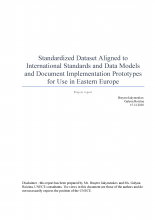
Report on standardized digitalization in Multimodal transport UA
This report covers the results of a pilot project in the implementation of: (a) the recommendations of the 2019 and 2020 Odessa trade facilitation seminars of the United Nations Economic Commission for Europe (UNECE) to support the development of digital multimodal transport corridors to increase the harmonization and standardization of data exchange in international transport, trade and logistics to encourage electronic data exchange and thereby to reduce person-to-person contacts during the COVID-19 crisis and in the post-pandemic recovery, using relevant standards of the United Nations Centre for Trade Facilitation and Electronic Business (UN/CEFACT), a subsidiary body of the UNECE.
The aim is to foster the harmonization of electronic data sharing using global (UN/CEFACT) standards for transport, trade and logistics, and to prepare standards for e-documents based on the UN/CEFACT semantic standards and reference data models. The focus will be on the development of electronic document equivalents for the documents mentioned above, using UN/CEFACT tools in the countries developing a digital multimodal transport corridor.
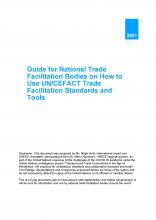
Guide for National Trade Facilitation Bodies on How to Use UN/CEFACT Trade Facilitation Standards and Tools
The COVID-19 pandemic significantly disrupted supply chains and global trade flows and affected delivery of public services. As part of the emergency response, governments worldwide adopted measures to fast-track imports of essential goods and medical supplies, and to provide public services while maintaining contact restrictions and changes in staff assignments. They also adopted provisional measures to digitalize information exchange or just receive scanned or photographed copies of documents, to verify content through electronic means and to reduce the frequency of physical inspections of goods and means of transport.
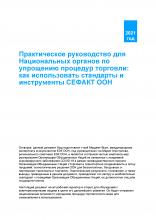
Практическое руководство для Национальных органов по упрощению процедур торговли: как использовать стандарты и инструменты СЕФАКТ ООН
Пандемия коронавирусного заболевания COVID-19 существенно нарушила цепи поставок и дестабилизировала глобальные торговые потоки, а также оказала воздействие на предоставление государственных услуг. В качестве мер экстренного реагирования на чрезвычайные ситуации, правительствами стран были введены упрощенные процедуры как для импорта товаров первой необходимости и предметов медицинского назначения, так и для предоставления государственных услуг, при одновременном сохранении ограничений на контакты между людьми и принятии изменений в процедурах назначения сотрудников. Административные органы по всему миру также ввели временные меры по цифровизации информационного обмена, либо же в целях обеспечения возможности принятия отсканированных или сфотографированных копий документов, проведения проверок соответствия информации электронным образом, а также для снижения частоты проведения физических инспекций грузов и транспортных средств.
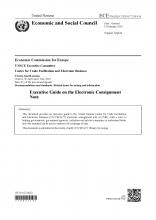
eCMR Standard package
The Convention on the Contract for the International Carriage of Goods by Road (CMR) was developed in 1956. This convention standardizes contractual and carrier liability conditions of transporting goods by road in vehicles for reward if the origin and destination are in two different countries, and at least one of the countries is a contracting party. It has been acceded to by 55 states around the world, thus making the use of the CMR obligatory in these countries. In 1976, the International Road Union introduced a United Nations Layout Key aligned CMR Note template in cooperation with the International Chamber of Commerce. This road consignment note template was updated in 2007 and is now used by most, if not all, parties to contracts of carriage in CMR contracting countries.

Online Course on Enhancing Trade Information Portals
Trade information portals (TIPs), sometimes also called National Trade Portals/Repositories (NTP/Rs), are websites where one can obtain information on laws, regulations and procedures that need to be followed when engaging in international trade. The information and services provided through TIPs have the potential to enhance regulatory transparency and greatly facilitate trade. While many countries already have some forms of TIPs, ensuring their effectiveness and sustainability often remains a challenge. The objective of this online course on enhancing TIPs is to provide a framework and guidelines for assessing the as-is conditions of a TIP and generating recommendations for its improvement.
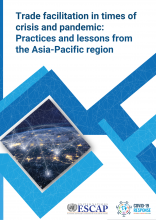
Trade facilitation in times of pandemic: practices and lessons from the Asia-Pacific region
The Coronavirus 2019 (COVID-19) pandemic has hit international trade worldwide and in Asia and the Pacific, underscoring the importance of maintaining trade connectivity not only for the immediate pandemic response, but also for the subsequent recovery efforts in order to build resilience to future disruptions. The report first describes, in the section II, the initial developments and lessons learnt in trade and transport facilitation practices in response to the COVID-19 pandemic. Section III presents the results of a Survey on trade facilitation in times of crisis and pandemic in the Asia and the Pacific region. Finally, Section IV discusses the ways forward for trade facilitation measures to support a sustainable and resilient recovery from the COVID-19 crisis and how the Asia-Pacific region can be better equipped to build back better.
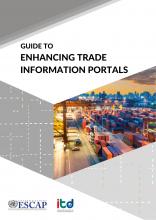
Guide to enhancing Trade Information Portals
The Guide to enhancing Trade Information Portals proposes a governance framework and guidelines that can be used as an assessment and improvement roadmap, especially for assessing the current or as-is conditions of an existing Trade Information Portals (TIPs), and then generating recommendations for further enhancing its quality and impacts. The readers of this guide will learn how to evaluate and generate recommendations for enhancing the effectiveness and the sustainability of TIPs.
Readers of the Guide are recommended to take the online course on enhancing Trade Information Portals (TIPs). The online course is available HERE.